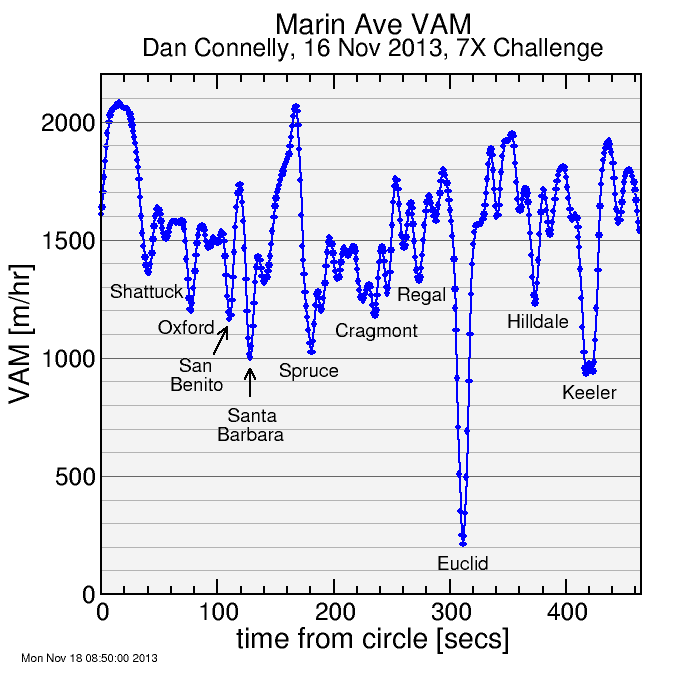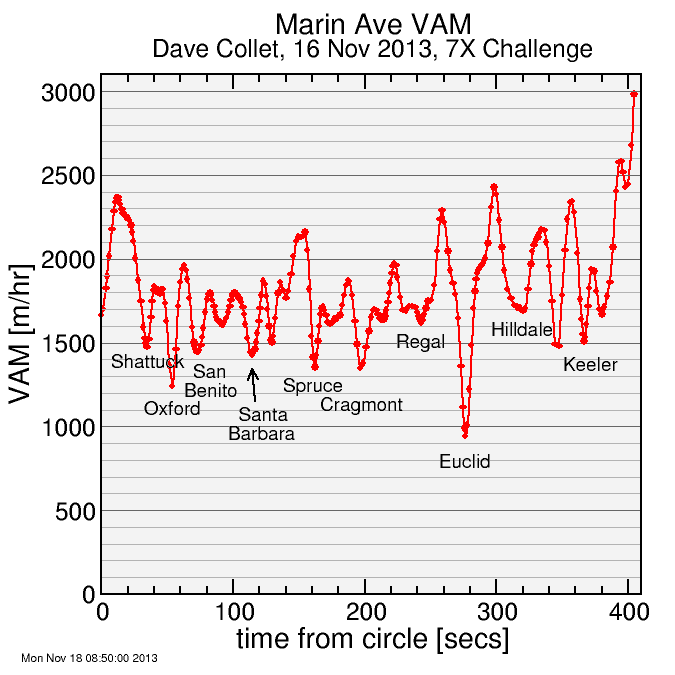VAM analysis of climbing Marin Ave in Low-Key Hillclimbs 7X Challenge
Marin Ave isn't like most other climbs. With Marin, it becomes as much a matter of survival as of speed. Speed is desired as much because it ends the suffering sooner as because of the desire for any target time, placing, or Low-Key Hillclimb points. Yet in the case of Saturday's 7X challenge of course the placing and the points were still important.
A nice thing about metrology data is they tell a rich story if examined closely enough. In this case I didn't have a power meter, my PowerTap too heavy for timed hillclimbs, so I have to rely on other ways to judge my effort. On a climb this steep, VAM is a nice proxy for power, so I use that to judge my pacing.
VAM extracted by numerically differentiating measured altitude with respect to time is inherently noisy, especially on a Garmin Edge 500 where altitude is reported with 1-meter resolution. So to get meaningful numbers I convolved the result with a Gaussian of sigma 3 seconds. This smooths the VAM to something which works fairly well. A longer time constant would lose any resolution of the plateaus which are the ten cross streets delineating the 11 blocks which comprise Marin Ave.
Here's the profile, in all of its nastiness:

Of the first eight blocks, only one, the block to Spruce, is really steep. Marin Ave's heart lays at the end. In a way the first eight blocks are there just to prepare you for that. I knew this, having ridden Euclid twice before, and having studied the profile before that.
WIth this in mind, here's the VAM data from my ride on Saturday, where the data end where the final checkpoint is triggered, which is approximately 5 vertical meters below the finish (in order to provide a buffer for GPS error).

I hit the first block, to Shattuck, fairly hard. My legs felt good despite having made a maximal effort up Lomas Cantadas ending less than an hour earlier. But then I settled into a more sustainable effort. I was holding back, waiting, keeping something in reserve for what I knew to be coming.
On the steep block to Spruce my VAM naturally increased, as I tried to keep a reasonable cadence in what was already my lowest gear, 34-27. From here it was 3 more blocks to Euclid. I kept the gear spinning. I was gaining on the tandem a few blocks ahead. I wanted to make good time even if I was holding a little bit back to survive my approaching fate.
But when I hit Euclid, reality was still a sobering blow. You can see my VAM drop dramatically here as I first freewheeled, then softpedaled across the road. The grim inevitability of the pain which was to follow hit home. All I could do is postpone my fate, even if for only a small number of seconds.
Then I was there: on the brutal slopes of the first of the final three blocks, to Hilldale. My VAM jumped here simply because I had no other choice. To keep turning the pedals at a reasonable cadence meant my vertical speed had to increase.
I hit the next block without much hesitation. Again, I kept the pedals turning. Still brutal, it's slightly less steep than the preceding block, so my survival-mode VAM dropped a bit.
My legs were pretty much empty now, yet I had one block left. Again, I paused slightly at the cross-street, collecting the will for the final wall to freedom. My legs hurt, and they would soon hurt more, but only for a brief time. Then I would be done.
The last block I went at my maximum: the tandem was right there, having finished soon before. But I was near empty, I had nothing left. My VAM increased but not by much more than my cadence demanded.
So there it was. Of the 9 riders in my division (human-powered male solo riders) I had the third best time, a personal record of three tries. Success. Yet it's interesting to compare my effort to that of the fastest rider in the division, David Collet.
 His effort follows some similar patterns to mine. But his VAM on blocks during the first 8 blocks was more consistent than mine. He was less conservative, pushing himself harder on the less steep blocks, saving himself less. At Euclid, the massive drop in VAM in which I indulged to prepare mentally and physically for the final three blocks isn't seen in his data. He crossed Euclid with relatively little delay, throwing himself immediately into the final three blocks. The same was true on Keeler: no pause, just the beginning of an impressive sprint to Grizzly Peak.
His effort follows some similar patterns to mine. But his VAM on blocks during the first 8 blocks was more consistent than mine. He was less conservative, pushing himself harder on the less steep blocks, saving himself less. At Euclid, the massive drop in VAM in which I indulged to prepare mentally and physically for the final three blocks isn't seen in his data. He crossed Euclid with relatively little delay, throwing himself immediately into the final three blocks. The same was true on Keeler: no pause, just the beginning of an impressive sprint to Grizzly Peak.
The crux of Main is the final three blocks which follow Euclid. These blocks are occluded from view by Euclid's width. All that's visible is the stop sign at Euclid's leading edge, and only when you crest this rise does the brazen monstrosity of the final three blocks confront you. I'd ridden Marin twice before, and studied the profile before that, so I knew what was coming. Yet knowing and experiencing aren't the same thing, and it intimidates me every time.
There's no way I'm going to match David's time, but it's clear from his data a bit less mental intimidation, a bit more confidence, would have improved my pacing. But easier said than done. There's not many riders who aren't scared of the challenge Marin provides. Such grades, if you can find them on urban roads, are usually found for one, two, or maybe three blocks. Eleven consecutive blocks of this is hard to grasp. But I hope to have another shot at the hill when I'm fitter than I am now, just getting my fitness back after a prolonged focus on rehabbing from my June crash.

Comments